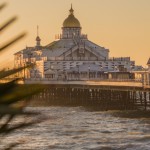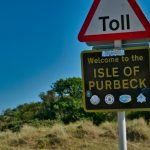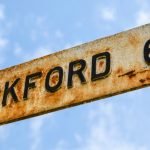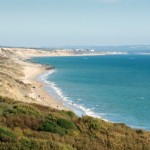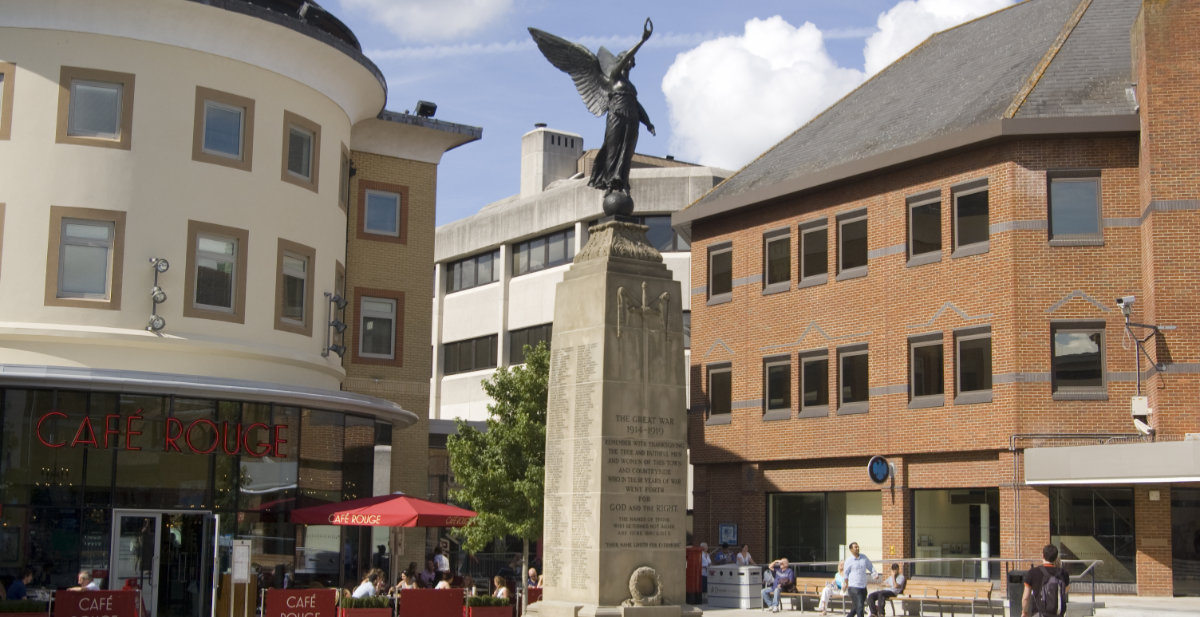
The Five Minute Guide to Woking. Get to know your town with one of our helpful travel guides.
Situated in Surrey, this sunny English town is all the way down in the south. That means it has better weather than most of us UK dwellers, making it an ideal staycation destination for stay-at-home-summer 2021.
Woking might be down where the good weather is, but it’s also in the part of the country that kept getting invaded all the time. We expect the history of this place to be fraught with bloodshed and adventure. We will be disappointed if that’s not true.
Let’s explore the history of a town that plays home to over a hundred thousand southern English citizens. There is bound to be some excitement if you would care to join us.
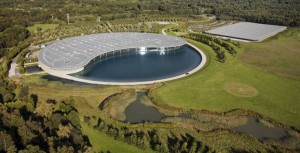
The Futuristic looking McLaren HQ.
Image: Hypercar/Shutterstock.com
The Early Days of Woking
Woking is mentioned as the site of an 8th-century monastery in its earliest appearance in the “official” books… but that’s only because we rely on religious records for most of our history here. The monastery would have been built in the land of the Woccingas tribe. They were the people that occupied the land before the Romans came.
After the Romans arrived and left, the name “Wocca” stuck around. The land was the designated site of Chertsey Abbey from late in the 7th century and into the 8th. At that time, Woking was in the Hundred of Godley (God’s Land). A Hundred was exactly that, a way for the overlords of the time to keep track of all the settlements by dividing them into hundreds.
What we can be sure of is that the town was possessed of both an Abbey and a Monastery, but not for long. The Abbey was excavated in recent years but nothing more ancient than its grounds lay underneath. It is considered that the monastery now lies underneath St Peter’s Church in the town.
Back then, the monastery of “Woccingas” was freed from all obligations to the king by Offa of Mercia. This would have been around the time of the Danelaw. In coastal settlements, the Vikings might even still have been attacking. It is thought that there was a Viking raid sometime in the 8-9th centuries, which would have forced the monastery or the Abbey to close, depending on what was still there at the time.
Woking In The Doomsday Book
The next mention of Woking isn’t until the Domesday Survey conducted in 1086. The survey was orchestrated by William the Conqueror, the Norman King. He had taken the country 20 years previously and now wanted to survey his kingdom… to coin a phrase. It became the first ordnance survey of its kind to be given in England. By the time the survey masters arrived in Woking, the religious establishments were already gone.
What the town did have in 1086, was a sizable number of 33 villagers and 9 smallholders. The town belonged to King William and had an annual value of 15 pounds. That was a lot of money for a town that hadn’t been mentioned for two hundred years. At that time, Woking included 32 acres of meadows, 133 swine in their own woodland, a mill for turning flour, a church, and 6 ploughlands. There were enough people in Woking in 1086 that they were able to summon 20 plough teams and 1 Lord’s plough team to man the meadows. All things considered; the early history of Woking saw it as a well-off town.
Woking in Medieval Times
Let’s skip ahead to Medieval times then. We’re not going to lie; we had expected a battle or five by now. Other than that 8/9th century Viking mishap, there hasn’t been anything juicy so far…
In 1272, the first mention of Woking Palace is made. Later records show it as a favourite of Henry VII and his son, Henry VIII. Up until 1503, it was simply a country holding, a manor house set in an estate with a natural town growing nearby. In 1503, Henry VIII (having grown to love the manor as a small boy) decided to turn it into a palace through renovations. He built a moat, added a Hall, and added the King’s Garden to the southwest. It was an affluent place at one point, now, of course, it lies in ruins.
In 1543, Woking Palace was finished. It was followed by Sutton Place being completed in 1530. Hoe Place was built in 1620 after the palace was gifted to Sir Edward Zouch, who abandoned it. The Wey Navigation was opened for traffic between the Thames and Guildford. The next interesting thing to happen in affluent-yet-sleepy Woking was when the Canal was built in 1794. This brought new life into the town by giving traders an easy access point to transport goods down the line to London. It was then that the history of the town truly started to unfold.
Let’s put a pause on it though, while we go and take a look at some of the fun things you never knew about this historic town, so you have something to talk about with the locals when you are there on holiday.
Fun Trivia about Woking
Here at Five Minutes Spare, we always go above and beyond the call of duty to find all the gossip we can on the towns we tour. Woking is no exception to the rule… but give the history so far, we’re not sure how interesting these are going to be…
- The town uses a new housing strategy to provide social housing. This means they keep to certain weird demographics. 19% of the population are under 14, 15% are over 65, and everyone else works for McLaren or Mustang down the road.
- Over 75% of all Woking residents are ‘economically active’, making it the second most economically active place in the country. There are some 4975 businesses in Woking… or there were before the pandemic.
- Nearly ¾ of all Woking households have one or more cars[i]. We told you it was affluent.
- The Shah Jahan Mosque in Woking was the first of its kind built in Britain.
- The Brookwood Cemetery in town is the largest in Britain. The attached park is a Grade I listed building. It stretches over 2000 acres.
- HG Wells lived on Horsell Common for a while. When he wrote War of the Worlds, that’s where the Martians landed[ii].
- The first-ever cremation in Britain took place in Woking Crematorium in 1885.
Woking, although sleepy, seems to have quite a lot going for it in terms of interesting and fun facts. Let’s get back to that history before we get carried away.
The Industrial Era in Woking
As we mentioned before, the arrival of the canal was what brought growth and prosperity to the people of Woking. In 1801 the recorded population was 2,459 people. By 1838 the railway arrived too, bringing further traffic for goods in and out of London. Woking’s arrival as a commuter town was born, and it was hailed as a pleasant place in the country, not too far from the city.
A second stop was added to the railway in 1854. This second line catered to that massive, 2,000-acre cemetery we talked about above. It was opened by the London Necropolis Company, proving once and for all that London under Queen Vic was an exceptionally morbid place. They even managed to pass some of that morbidity on to Woking. The Albion Hotel was built in 1857 to accommodate the day visitors from London, and a post office was built in 1865 to accommodate all the postcards they sent. Woking’s first shopping centre was built in 1870 with St Peter’s Church undergoing restoration in 1878.
By 1881 the census showed 8.554 souls in Woking. In 1889 the mosque was opened. In the same year, Woking FC was founded. The golf club followed in 1893. It took another three years before the people got together and formed the Woking Choral Society.
In 1901 the population was 18,802. The Hockey club was opened in 1904 and the cricket club was founded in 1905. A racing circuit was built in 1907 With a national bank added in the following year.
Modern History of Woking
A few short years before the outbreak of WWI saw Woking with a population of around 25,000 people. In 1917, the county council was forced to add a military cemetery within some of that 2000 acre graveyard earlier installed.
Many of the young men from the town – as with all towns – lost their lives in the trenches. The government’s PAL regiments saw buddies from the same town all lumped into the same units. They then died en masse in those trenches, leaving whole English towns with no young men for a generation. The Exploring Surrey pages have a nice tribute where they have collected some of the photos of the young men to put on display so that we can match the names to the faces.
In Woking, a war memorial was erected in 1922 in Victoria Gardens but was later moved to the town centre. In 1935, the town got its first swimming pool and, the following year, the train station was rebuilt. The racetrack closed when the Second World War started.
WWII
During WWII, the town became a refuge for London’s children. The Kilronnan Nursery was converted into a Red Cross home for children displaced by the war. Several buildings were commandeered, and air raid precautions went into full force. There were also plenty of allotments in town to support the Dig for Victory campaign. There was a war hospital in the area and troops were stationed in the Inkerman Barracks. You can learn everything you want to know about WWII Woking in the Woking History pages.
In 1958 the Woking Drama Festival had its first show. In 1967, the Winston Churchill School opened. By 1971, the population had grown to 75,973 people, not too far from the 100,000+ it has now. Woking Rugby Club was founded late, in 1989. In 1992 another shopping centre was added and the following year the Woking Mural was created. One of the town’s greatest periods of achievement was between 1994 and 1997 when the football club won the FA Trophy three times in four years.
Since the turn of the 21st century, Woking has
Famous People With A Woking Connection
There are numerous famous faces floating about Sainsbury’s in Woking. Check out some of the Five Minutes Spare favourites, below.
- Delia Smith – that’s right, the beloved TV chef known for sensuality (although we’re not sure why none of the male TV chefs is known for their sensuality… Just saying) was born here.
- The Spice Girls began their career out of Woking. They’re not all from here, but they started their group in Knaphill.
- Peter Davison – who was Doctor Who, went to school in Woking.
- Sean Lock – a comedian regularly appearing in 8 out of 10 cats, is a Woking man.
- Harry Hill – another Woking born comedian.
- Paul Weller – do we need to tell you who Paul Weller is? We hope not.
And countless others. Now we have got through all that history and have vanquished those famous faces, let’s move on to what there is to see and do in Woking if you happen to be passing through…
Woking Attractions
Whether you are there for a few days or a fortnight, check out the following Woking attractions.
Historic Sights and Landmarks
The New Victoria Theatre was erected back in the early 90s and is still in use to this day. Pop along and see a show as it is rated one of the top places in town. If there is a band or a passing troupe on, this is where they will pass through. At the time of writing, the biggest name on the program was a show by Jimmy Carr. Not bad for a small town in southwest England.
You can visit the remains of Woking Palace, which has been cordoned off and signposted so that you know what you are looking at. It really does lie in ruins nowadays, but it is fascinating to see one of the places one of the most notorious English Kings kept at least some of his wives. The Friends of Woking Palace are working to renovate and protect what is left. Give generously, if possible, they are mostly volunteers.
Finally in the list of historic sights you should see if you are ever in Woking, is the Shah Jehan Mosque. That’s right, that first mosque ever to have been built in Britain is still standing, still in use, and looks fantastic. It really does resemble a piece of opulent eastern grace just dropped neatly into a Woking town square. It’s beautiful. Go for a visit. It’s hard to believe it was built in 1889, it just looks too perfect.
Art Galleries and Museums
One of the places tourists love best in Woking is the Lightbox art gallery. This place runs regular exhibits with local and internationally renowned artists. It’s a good place to take the kids, a good place to spend the afternoon, and a nice place to learn something while you are in town.
Not so much of a museum as it is an experience, the Living Planet Centre is situated in the town centre and is the UK home of the World Wildlife Foundation. It represents the pinnacle of conservation on our planet, and it makes the town centre of Woking look that little bit more pleasant, too. Go along for a visit and a tour, all the money will go back towards preserving the world’s wildlife.
Outdoor Attractions
Weird as it is, a wander around the 2,000 acres cemetery is bound to find you a few treats. There are plenty of tombs to be creeped out by and some lovely pathways through the trees. It’s odd, yes, but it’s also the third top rate attraction in Woking according to Trip Advisor, so the general public must like weird. Situated in one small corner is the Brookwood Military Cemetery, which contains more white crosses than it should.
Next up for some outdoor fun, head to the Lightwater Country Park. Lightwater Village is nearby, and this park sits on the edge of it. It covers 59 acres of heathland, perfect for long walks. You can fish here with a day pass but not at night. It is an SSSI area which means it has been designated protected by the government. You should not cause any damage while inside an SSSI in case they arrest you. Picnics and long walks, however, are fine.
A third favourite outdoor attraction is Woking Park. There is a toddler play area called Welcome to the Jungle, a bandstand often used in the summer by local school and band groups, and a lot of space for all those office lunch break sunbathers. It takes up 43 acres (do you notice how none of the parks is as big as the cemetery?) and has some beautifully landscaped gardens. It is home to the Woking Beer Festival which usually takes place in September.
Sports and Recreation
Any Formula One fan will be pleased to hear that the historied and successful McLaren F1 Team is based in the town. The McLaren Technology Centre often runs tours of the establishment, although you would need to contact them in advance. However, if you just turned up we are sure they would let you have a quick look at some of the Super Cars they have in the Foyer. The building its self is also super-futuristic looking! Supercar fans will also enjoy a visit as would car buyers with a couple of hundred thousand pounds to spare. They are not cheap but boy do they turn heads!
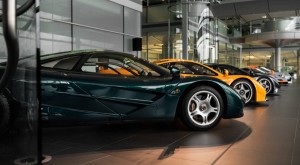
Some McLaren Super Cars in their Foyer. Image: AaronTsui/Shutterstock.com
Football
Fans of lower league football will love Woking as there are four clubs within the borough, which pretty much guarantees at least one will be playing at home during the season.
The towns main team are Woking FC who at the time of writing play in the National League (tier 5). They are one of the FA Trophy’s most successful teams have reached the final four, winning it on three of those visits. They have been around since 1887 and they play their home matches at the Laithewaite Community Stadium. You can get a bit more information on the Club here.
The other three nearby clubs all play in The Combined Counties Football League (tier 9 and 10) these being Knaphill FC, Sheerwater FC and Westfield FC.
Cricket
Woking is home to Pyrford Cricket Club who date back to 1858, making them one of Surrey’s oldest. They have a senior team that plays in the Surrey Championship and their ground can be found at Coldharbour Road GU22 8ST.
Golf
If you are a fan of the nation’s other favourite game, you will find three golf clubs within Teeing distance. Woking Golf Club is the most obvious. If you are looking for something a little different head to the Pyrford Lakes which as you can imagine has plenty of water hazards. Otherwise, you will be able to play golf at Hoebridge Golf Centre.
Shopping and Retail
Woking Shopping, near the Lightbox, is one of the best centres in town. You will also find that the Ripley Farmer’s Market is a great stop once a month. You can get all the fresh fruit and veg from the bountiful surrounding countryside here… it’s the definition of healthy eating.
Other Things to See and Do in Woking
Woking is so brimming full of attractions that we needed to add a separate section for all the things we missed out on the first time around. Here are all the other things you can do in Woking, should you get the chance.
- Head to the historic St Nicholas’ Church if you are of a religious nature. It’s a gorgeous old village-style church with a mini spire.
- Visit Pyrford Lock where you can see the still-functioning canal in full operation.
- Pyrford Common is another lovely area for a stroll with the kids.
- Visit the pretty Papercourt Lake. In the summer, you might even be able to go boating in it.
There are still loads of things left to do in town, but we think we’ve managed to give you a good insight into the fun that could be had if you were in Woking for a few days. Enjoy!
How to get there?
We’ve almost brought you up to speed on this fascinating little town. All that’s left is to show you the way to go.
By Road
Follow the A3 south and west out of London and you’ll be there in no time.
By Rail
Woking train station is on the Southwestern Railway line.
By Air
Heathrow airport is nearest to Woking.
By Boat
The River Wey cuts through town as does the Basingstoke Canal which connects the town with the River Thames. If you try it let us know!
Got Five Minutes?
If you still find yourself with the wanderlust, you can always head to our travel pages and have a browse. We have all sorts of fun facts on all sorts of towns… you might even find your own in there.
[i] https://www.morrlaw.com/article/22-fascinating-facts-about-woking/
[ii] https://information-britain.co.uk/didyouknow.php?town=Woking&county=5

